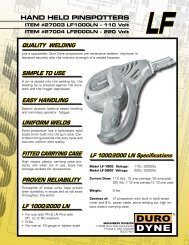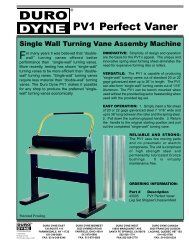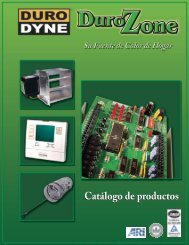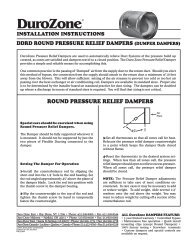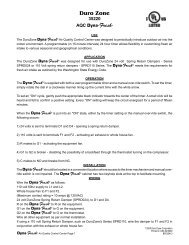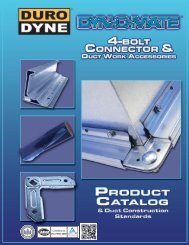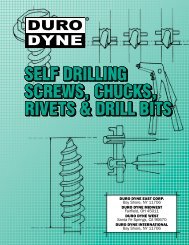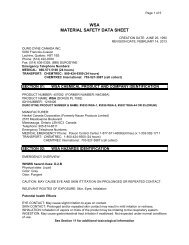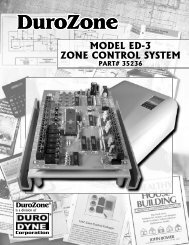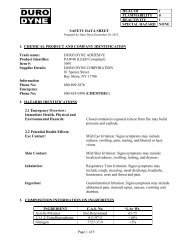IA-94 Adhesive - Duro Dyne
IA-94 Adhesive - Duro Dyne
IA-94 Adhesive - Duro Dyne
Create successful ePaper yourself
Turn your PDF publications into a flip-book with our unique Google optimized e-Paper software.
<strong>IA</strong>-<strong>94</strong>MATER<strong>IA</strong>L SAFETY DATA SHEETPage 1 of 7DURO DYNE CANADA INC.5030 Francois-CussonLachine, Quebec H8T 1B3Phone: (514) 422-9760Fax: (514) 636-0328, (888) DURODYNEEmergency Telephone Number: (781) 878-7015 (Business Hours)CANUTEC Emergency Telephone Number: (613) 996-6666CREATION DATE: JUNE 26, 1990REVISION DATE: OCTOBER 19, 2012SECTION 01:<strong>IA</strong>-<strong>94</strong> PRODUCT AND COMPANY IDENTIFICATIONPRODUCT NAME: <strong>Duro</strong> <strong>Dyne</strong> <strong>Adhesive</strong> item #DUR016 & DUR017PRODUCT CODE: (<strong>IA</strong>-<strong>94</strong>-1=DUR017, <strong>IA</strong>-<strong>94</strong>-5=DUR016) FORMER #15-146RMANUFACTURER:ITW TACC56 Air Station Industrial ParkRockland, MA 02370Emergency Telephone Number: (781) 878-7015 (Business Hours)Service Number: (800) 503-6991CANUTEC Emergency Telephone Number: (613) 996-6666SECTION 02:<strong>IA</strong>-<strong>94</strong> HAZARDS IDENTIFICATIONEMERGENCY OVERVIEWIMMED<strong>IA</strong>TE CONCERNS: DANGER! Extremely flammable liquid and vapour. Vapour may cause flashfire and explosion. Harmful or fatal if swallowed. Harmful if absorbed through the skin. Pulmonaryaspiration hazard. After ingestion, may enter lungs and produce damage. High vapour concentrations maycause drowsiness. Can cause eye, skin and respiratory tract irritation.POTENT<strong>IA</strong>L HEALTH EFFECTSEYES: Can cause severe eye irritation and corneal damage.SKIN: Causes defatting and skin irritation. Can cause dermatitis.SKIN ABSORPTION: May be absorbed through the skin in harmful amounts.INGESTION: Can cause gastrointestinal irritation, nausea and vomiting. Aspiration of material into thelungs may cause chemical pneumonitis, which can be fatal. Harmful or fatal if swallowed.INHALATION: May cause nose or throat irritation. High concentrations may lead to central nervoussystem effects (drowsiness, dizziness, nausea, headaches, paralysis and loss of consciousness).SIGNS AND SYMPTOMS OF OVEREXPOSUREEYES: Liquid and vapour can severely irritate the eyes depending on type of exposure (splash, vapour)and exposure time.SKIN: Mild to moderate skin irritant.
SECTION 02:<strong>IA</strong>-<strong>94</strong> HAZARDS IDENTIFICATION ContinuedPage 2 of 7SKIN ABSORPTION: May be absorbed through the skin and can contribute to overall exposure. Effectsare similar to CNS depression.INGESTION: May result in central nervous system (CNS) depression with symptoms such as headaches,nausea, vomiting, diarrhea, dizziness, incoordination and unconsciousness. Aspiration of material intolungs may cause chemical pneumonitis which can be fatal.INHALATION: High vapour concentrations may cause CNS depression with symptoms including lightheadedness, giddiness, nausea, drowsiness, headache, nose, throat and respiratory tract irritation,reduced appetite, confusion and unconsciousness.ACUTE TOXICITY: High vapour concentrations may cause central nervous system (CNS) depressionwith symptoms including light headedness, giddiness, nausea, drowsiness, headache, nose, throat andrespiratory tract irritation, reduced appetite, confusion and unconsciousness.CHRONIC EFFECTS: damage to the central nervous system of the extremeties, peripheral neuropathy,with symptoms including numbness, tingling and weakness in the toes and fingers, sensory impairment totouch, pain, vibration and temperature, muscular weakness, blurred vision, coldness of extremeties, lossof body weight and reflexes, and even paralysis. Frequent or prolonged contact may irritate the skin andcause a skin rash (dermatitis).ROUTES OF ENTRY: Eye Contact, Ingestion, Inhalation, Skin Absorption and Skin Contact.TARGET ORGANS STATEMENT: Central Nervous System (CNS)IRRITANCY: Eyes, nose, throat, respiratory tract and skin irritation.SECTION 03:<strong>IA</strong>-<strong>94</strong> COMPOSITION / INFORMATION ON INGREDIENTSChemical Name Wt. %CASNumberF” Highly Flammable “Xn” Harmful “Xi” Irritant “N” Dangerous for the environment(Full text of R_Phrases can be found under heading 16)SECTION 04: <strong>IA</strong>-<strong>94</strong> FIRST AID MEASURESEINECSn-Hexane 15 - 40 110-54-3 203-777-6Low Boiling Point Naphtha-Solvent Naphtha (petroleum),Light AliphClassification10 - 30 64742-89-8 265-192-2 Xn; R65n-Heptane 10 - 30 142-82-5 265-192-2Cyclohexane 3 - 10 110-82-7 203-806-2 F; R11Cyclopentane 1 - 5 287-92-3 206-016-6 F; R11F,Xn,N;R11,R48/20,R62,R65,R67,R51/53F,Xi,N;R11,R38,R50/53,R65,R67EYES: Immediately flush eyes with plenty of tempered water (at least 15-20 minutes) lifting upper andlower eye lids occasionally. Get immediate medical attention.SKIN: Immediately wash skin with soap and plenty of water. Remove contaminated clothing. Get medicalattention if symptoms occur. Wash or dispose of clothing before reuse.INGESTION: Do not induce vomiting, keep person warm, quiet and get medical attention immediately. Ifvomiting occurs naturally, have victim lean forward to reduce the risk of aspiration. Aspiration of thismaterial into the lungs due to vomiting can cause chemical pneumonitis which can be fatal.INHALATION: Remove to fresh air. If not breathing, give artificial respiration or give oxygen by trainedpersonnel. Seek immediate medical attention.
SECTION 05:<strong>IA</strong>-<strong>94</strong> FIRE FIGHTING MEASURESPage 3 of 7FLASHPOINT AND METHOD: -37°C (-35°F) TAG CCFLAMMABLE LIMITS: 1.1 TO 8.6AUTOIGNITION TEMPERATURE: 204°C (47.3°F) to 361°CFLAMMABLE CLASS: Class IBGENERAL HAZARD: Flammable liquid and vapour.EXTINGUISHING MED<strong>IA</strong>: Foam, dry chemical, carbon dioxide, water spray or fog.HAZARDOUS COMBUSTION PRODUCTS : Carbon Monoxide, Carbon Dioxide, AldehydesEXPLOSION HAZARDS: Avoid fire, sparks, static electricity and hot surfaces. Liquid readily evaporates atroom/ambient temperature. Vapours are invisible, flammable, heavier than air, and may accumulate in lowareas and spread long distances. Distant ignition and flashback are possible.FIRE FIGHTING PROCEDURES: As in any fire, wear self-contained breathing apparatus with pressuredemand,full face piece SCBA (MSHA/NIOSH approved or equivalent) and full protective gear.SENSITIVE TO STATIC DISCHARGE: Likely to catch fire from near-by spark. Static charge mayaccumulate by flow or agitation. Grounding and bonding of containers is required.SENSITIVITY TO IMPACT: None known.HAZARDOUS DECOMPOSITION PRODUCTS: Carbon Monoxide and Carbon Dioxide may form whenheated to decomposition.SECTION 06:<strong>IA</strong>-<strong>94</strong> ACCIDENTAL RELEASE MEASURESSMALL SPILL: Dike area to contain spill. Take precautions as necessary to prevent contamination ofground and surface waters. Recover spilled material on absorbent, such as sawdust or vermiculite, andsweep into closed containers for disposal. After all visible traces, including ignitable vapours have beenremoved thoroughly, wet vacuum the area. Do not flush to sewer. If area of spill is porous, remove asmuch contaminated earth and gravel, etc. as necessary and place in closed containers for disposal. Onlythose persons who are adequately trained, authorized and wearing the required personal protectiveequipment (PPE) should participate in spill response and clean-up.LARGE SPILL: Keep spectators away. Only those persons who are adequately trained, authorized andwearing the required personal protective equipment (PPE) should participate in spill response and cleanup.Ventilate the area by natural means or by explosion proof mechanical means (i.e. fans). Know andprepare for spill response before using or handling this product. Eliminate all ignition sources (flames, hotsurfaces, portable heaters and sources of electrical, static, or frictional sparks). Dike and contain spill withinert material (e.g. sand, earth). Transfer liquids to covered and labelled metal containers for recovery ordisposal, or remove with inert absorbent. Use only non-sparking tools and appropriate PPE. Placeabsorbent diking materials in covered metal containers for disposal. Prevent contamination of sewers,streams and groundwater with spilled material or used absorbent.SECTION 07:<strong>IA</strong>-<strong>94</strong> HANDLING AND STORAGEGENERAL PROCEDURES: For professional or industrial use only. Follow label instructions. Keep out ofthe reach of children. Not for consumption. No smoking. Do not breath vapours. Avoid contact with body.Turn off all pilot lights, flames, stoves, heaters, electric motors, welding equipment and other sources ofignition. Empty containers must not be washed and re-used for any purpose. Contact lens wearers mustwear protective eye wear around chemical vapours and liquid. Wash hands thoroughly after handling.Flammable vapours may cause flash fire or ignite explosively. To prevent build-up of vapours, useadequate natural and/or mechanical ventilation (e.g. open all windows and doors to achieve crossventilation). Containers may be hazardous when empty. Never use welding or cutting torch on or nearcontainer. Do not cut, drill, grind or expose containers to heat, sparks, static electricity or other source ofignition. Explosion may occur causing injury or death.HANDLING: Use adequate ventilation and appropriate respiratory protection to avoid breathing vapourswhen cover is removed. Ground and bond all equipment when handling flammable solvent-borne material.STORAGE: Keep container closed when not in use. Store in a dry well ventilated area, out of the sun andaway from ignition sources. Do not remove or deface label. Prevent water or moist air from enteringcontainer.STORAGE TEMPERATURE: 15.5°C (60°F) Minimum to 35°C (95°F) Maximum.SHELF LIFE: 1 year from manufacture date.
SECTION 08:<strong>IA</strong>-<strong>94</strong> EXPOSURE CONTROLS / PERSONAL PROTECTIONPage 4 of 7EXPOSURE GUIDELINESOSHA HAZARDOUS COMPONENTS (29 CFR1910.1200)n-HexaneEXPOSURE LIMITSOSHA PELACGIH TLVCHEMICAL NAME ppm mg/m 3 ppm mg/m 3Low Boiling Point Naphtha – SolventNaphtha (petroleum), Light Aliph.n-HeptaneCyclohexaneTWA 500 ppm [1] 1800 mg/m3 [1] 50 ppm 176 mg/m3STEL NL [2] NL [2] NL [2] NL [2]TWA 400 ppm NL 400 ppm NLSTEL NL [2] NL [2] NL [2] NL [2]TWA 500 ppm [1] 2000 mg/m3 [1] 400 ppm 1640 mg/m3STEL NL [2] NL [2] 500 ppm 2050 mg/m3TWA 300 ppm [1] 1050 mg/m3 [1] 100 ppm 334 mg/m3STEL NL [2] NL [2] NL [2] NL [2]TWA NL [2] NL [2] 600 ppm 1720 mg/m3CyclopentaneSTEL NL [2] NL [2] NL [2] NL [2]Footnotes:1. OSHA limits per 29 CFR 1910.1000 Table Z-1 & Z-22. NL = Not ListedENGINEERING CONTROLS: Provide sufficient explosion proof mechanical (general and/or localexhaust) ventilation to maintain exposure below the occupational exposure limit and exposureconcentration.PERSONAL PROTECTIVE EQUIPMENT:EYES AND FACE: Wear safety glasses with side shields (or goggles) or a full face respirator.SKIN: Wear chemical protective clothing & boots to prevent repeated or prolonged skin contact.RESPIRATORY: NIOSH/MSHA approved air purifying respirator with an organic vapour cartridge orcanister may be permissible under certain circumstances where airborne concentrations are expected toexceed exposure limits. Protection provided by air purifying respirators is limited. Use a positive pressureair supplied respirator if there is any potential for an uncontrolled release, exposure levels are not knownor any other circumstances where air purifying respirators may not provide adequate protection. Arespiratory protection program that meets OSHA 1910.134 and ANSI Z88.2 requirements must befollowed whenever workplace conditions warrant a respirator’s use.PROTECTIVE CLOTHING: Wear chemical resistant gloves, such as nitrile rubber.WORK HYGIENIC PRACTICES: Wash hands thoroughly after use.SECTION 09:<strong>IA</strong>-<strong>94</strong> PHYSICAL AND CHEMICAL PROPERTIESPHYSICAL STATE: LiquidODOR: Solvent-likeCOLOR: RedpH: Not DeterminedPERCENT VOLATILE: 67.6Notes: by weightBOILING POINT: 49.5°C (121°F) to 98°C (209°F)FLASHPOINT AND METHOD: -37°C (-35°F) TAG CCSOLUBILITY IN WATER: SlightEVAPORATION RATE: > 1.0 (n-Butyl Acetate=1)DENSITY: 6.33 lbs/galSPECIFIC GRAVITY: 0.759(VOC): 513.100 gr/L EPA Method 24 VOCNotes: Photochemically Reactive Only VOC: 513.1 gr/LCOMMENTS: 0.84 lb VHAP/lb Solid27.1% by weight HAP
SECTION 10:<strong>IA</strong>-<strong>94</strong> STABILITY AND REACTIVITYPage 5 of 7STABLE: YesHAZARDOUS POLYMERIZATION: NoSTABILITY: StablePOLYMERIZATION: Product will not undergo polymerization.CONDITIONS TO AVOID: Avoid fire, sparks, static electricity and hot surfaces.POSSIBILITY OF HAZARDOUS REACTIONS: None Expected.HAZARDOUS DECOMPOSITION PRODUCTS: Carbon monoxide and carbon dioxide may form whenheated to decomposition.INCOMPATIBLE MATER<strong>IA</strong>LS: Strong oxidizing agents, strong acids and strong bases.SECTION 11:<strong>IA</strong>-<strong>94</strong> TOXICOLOGICAL INFORMATIONACUTEChemical Name ORAL LD 50 (rat) DERMAL LD 50 (rabbit) INHALATION LC 50 (rat)n-Hexane 25000 mg/kg No data48000 ppm(4-hr dose)Low Boiling Point Naphtha- Solvent Naphtha(petroleum), Light Aliph.> 2000 mg/kg > 2000 mg/kg> 5000 ppm(1-hr dose)n-Heptane > 15000 mg/kg > 2001 mg/kg10300 mg/cub m(4-hr dose)Cyclohexane 29820 mg/kg No data No dataCyclopentane > 5000 mg/kg No data> 5.62 mg/L(4-hr dose)IRRITATION: Eyes, nose, throat, respiratory tract irritation.SYNERGISTIC MATER<strong>IA</strong>LS: The neurotoxic effects of n-hexane vapour can be enhanced in rats by bothmethyl ethyl ketone (MEK) and lead acetate, but are decreased by toluene. Toluene and xylene preventtesticular atrophy by n-hexane.SECTION 11:<strong>IA</strong>-<strong>94</strong> TOXICOLOGICAL INFORMATION ContinuedSYNERGISTIC MATER<strong>IA</strong>LS: The neurotoxic effects of n-hexane vapour can be enhanced in rats by bothmethyl ethyl ketone (MEK) and lead acetate but are decreased by toluene. Toluene and xylene preventtesticular atrophy by n-hexane.SECTION 12:<strong>IA</strong>-<strong>94</strong> ECOLOGICAL INFORMATIONENVIRONMENTAL DATA: This product contains components that will normally float on water. Thesecomponents may be harmful to aquatic organisms and may cause long term adverse effects in the aquaticenvironment.ECOTOXICOLOGICAL INFORMATION: Contains components that are potentially toxic to freshwater andsaltwater ecosystems.BIOACCUMULATION/ACCUMULATION: Contains components with the potential to bio-accumulate.SECTION 13:<strong>IA</strong>-<strong>94</strong> DISPOSAL CONSIDERATIONSDISPOSAL METHOD: Dispose of in accordance with all local, state and federal regulations.
SECTION 14:<strong>IA</strong>-<strong>94</strong> TRANSPORT INFORMATIONPage 6 of 7DOT (DEPARTMENT OF TRANSPORTATION)PROPER SHIPPING NAME: <strong>Adhesive</strong>sPRIMARY HAZARD CLASS/DIVISION: 3UN / NA NUMBER: 1133PACKING GROUP: IINAERG: 128MARINE POLLUTANT #1: NoneOTHER SHIPPING INFORMATION: Contains (n-Hexane, n-Heptane)SPEC<strong>IA</strong>L SHIPPING NOTES: If individual container size is less than 1.3 gallons, the proper shippingname is :ORM-D Consumer CommodityNon-RegulatedSECTION 15:<strong>IA</strong>-<strong>94</strong> REGULATORY INFORMATIONUNITED STATESDOT LABEL SYMBOL AND HAZARD CLASSIFICATIONFlammable Liquid** for container > 1.3 gallons (4.9 Liters) **SARA TITLE III (SUPERFUND AMENDMENTS AND REAUTHORIZATION ACT)FIRE: Yes PRESSURE GENERATING: No REACTIVITY: No ACUTE: Yes CHRONIC: YesEPCRA SECTION 313 SUPPLIER NOTIFICATIONChemical Name Wt.% CASn-Hexane 15 – 40 110-54-3Cyclohexane 3 – 10 110-82-7CERCLA (COMPREHENSIVE RESPONSE, COMPENSATION, AND L<strong>IA</strong>BILITY ACT)Chemical Name Wt.% CERCLA RQn-Hexane 15 – 40 5,000 lbsCyclohexane 3 – 10 1,000 lbsTSCA (TOXIC SUBSTANCE CONTROL ACT)Chemical Name CAS TSCA SECTIONn-Hexane 110-54-3Low Boiling Point Naphtha – Solvent Naphtha (petroleum),Light Aliph. 64742-89-8n-Heptane 142-82-5 12b,Cyclohexane 110-82-7Cyclopentane 287-92-3CLEAN AIR ACTChemical Name Wt.% CASn-Hexane 15 – 40 110-54-3
SECTION 15: <strong>IA</strong>-<strong>94</strong> REGULATORY INFORMATION ContinuedPage 7 of 7CANADAWHMIS HAZARD SYMBOL AND CLASSIFICATIONFlammable Liquid - Class B Div 2Toxic - Class D Div 2 Sub Div BSECTION 16:<strong>IA</strong>-<strong>94</strong> OTHER INFORMATIONRELEVENT R-PHRASES:R11: Highly flammable.R48/20: Harmful: danger of serious damage to health by prolonged exposure through inhalation.R62: Possible risk of impaired fertility.R65: Harmful: may cause lung damage if swallowed.R67: Vapours may cause drowsiness and dizziness.R51/53: Toxic to aquatic organisms, may cause long-term adverse effects in the aquatic environment.R38: Irritating to skin.R50/53: Very toxic to aquatic organisms, may cause long-term adverse effects in the aquatic environment.INFORMATION CONTACT: (781) 878-7015PREPARED BY: <strong>Duro</strong> <strong>Dyne</strong> Canada Inc. 514-422-9760REVISION SUMMARY: This MSDS replaces <strong>Duro</strong> <strong>Dyne</strong> Canada November 4, 2009 MSDS.GENERAL STATEMENTS:Keep out of reach of children.For professional or industrial use only.If you cannot read, or do not understand all directions, cautions, and warnings, do not use this product.For spray applications, use only with approved equipment.** The information given and the recommendations made herein apply to our product(s) alone andare not combined with other product(s). Such are based on our research and on data from otherreliable sources and are believed to be accurate. No Guarantee of accuracy is made. It is thepurchaser's responsibility before using any product to verify this data under their own operatingconditions and to determine whether the product is suitable for their purposes. **



